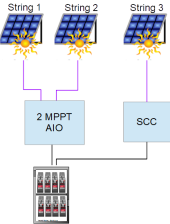svetz
Works in theory! Practice? That's something else
I Like @wattmatters' solution, make the top the same angle as the sides and it's just two strings. Alternatively, run the last set of panels with microinverters and feed them to a hybrid inverter (i.e., AC coupled)? With the low power panels, you should be able to get inexpensive microinverters.



